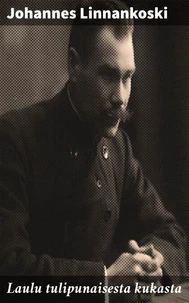The Song of the Blood - Red Flower
Par :Formats :
Disponible dans votre compte client Decitre ou Furet du Nord dès validation de votre commande. Le format ePub est :
- Compatible avec une lecture sur My Vivlio (smartphone, tablette, ordinateur)
- Compatible avec une lecture sur liseuses Vivlio
- Pour les liseuses autres que Vivlio, vous devez utiliser le logiciel Adobe Digital Edition. Non compatible avec la lecture sur les liseuses Kindle, Remarkable et Sony
 , qui est-ce ?
, qui est-ce ?Notre partenaire de plateforme de lecture numérique où vous retrouverez l'ensemble de vos ebooks gratuitement
Pour en savoir plus sur nos ebooks, consultez notre aide en ligne ici
- Nombre de pages154
- FormatePub
- ISBN859-65--4714277-5
- EAN8596547142775
- Date de parution01/08/2022
- Protection num.Digital Watermarking
- Taille378 Ko
- Infos supplémentairesepub
- ÉditeurDIGICAT
Résumé
In "The Song of the Blood-Red Flower, " Johannes Linnankoski provides a poignant exploration of the profound connection between nature and human experience. The novel, set against the backdrop of rural Finland, weaves a rich tapestry of imagery and metaphor, reflecting the author's lyrical style that is both evocative and deeply rooted in Finnish cultural identity. Through the story of its protagonist, Linnankoski delves into themes of love, loss, and the indomitable spirit of life, effectively situating his work within the broader literary context of early 20th-century Finnish realism, augmented by strands of romanticism and modernist thought.
Johannes Linnankoski, whose real name was Taito Kalevi Sali, was deeply influenced by the natural landscapes of Finland, an affinity that permeates his writing. His experiences as a schoolteacher and his profound appreciation for Finnish folklore and mythology informed his narrative style and thematic choices in this work. Linnankoski's literary journey was marked by a desire to capture the essence of Finnish identity at a time when the nation was on the cusp of independence, making "The Song of the Blood-Red Flower" an essential reflection of both personal and national awakening.
This captivating novel warrants a place on the bookshelf of anyone eager to explore the depths of the human soul as reflected through the prism of nature. Readers seeking a lyrical, profound meditation on life, interwoven with Finnish tradition, will find in Linnankoski's work not only aesthetic beauty but also a resonant call to embrace the complexities of existence.
Johannes Linnankoski, whose real name was Taito Kalevi Sali, was deeply influenced by the natural landscapes of Finland, an affinity that permeates his writing. His experiences as a schoolteacher and his profound appreciation for Finnish folklore and mythology informed his narrative style and thematic choices in this work. Linnankoski's literary journey was marked by a desire to capture the essence of Finnish identity at a time when the nation was on the cusp of independence, making "The Song of the Blood-Red Flower" an essential reflection of both personal and national awakening.
This captivating novel warrants a place on the bookshelf of anyone eager to explore the depths of the human soul as reflected through the prism of nature. Readers seeking a lyrical, profound meditation on life, interwoven with Finnish tradition, will find in Linnankoski's work not only aesthetic beauty but also a resonant call to embrace the complexities of existence.
In "The Song of the Blood-Red Flower, " Johannes Linnankoski provides a poignant exploration of the profound connection between nature and human experience. The novel, set against the backdrop of rural Finland, weaves a rich tapestry of imagery and metaphor, reflecting the author's lyrical style that is both evocative and deeply rooted in Finnish cultural identity. Through the story of its protagonist, Linnankoski delves into themes of love, loss, and the indomitable spirit of life, effectively situating his work within the broader literary context of early 20th-century Finnish realism, augmented by strands of romanticism and modernist thought.
Johannes Linnankoski, whose real name was Taito Kalevi Sali, was deeply influenced by the natural landscapes of Finland, an affinity that permeates his writing. His experiences as a schoolteacher and his profound appreciation for Finnish folklore and mythology informed his narrative style and thematic choices in this work. Linnankoski's literary journey was marked by a desire to capture the essence of Finnish identity at a time when the nation was on the cusp of independence, making "The Song of the Blood-Red Flower" an essential reflection of both personal and national awakening.
This captivating novel warrants a place on the bookshelf of anyone eager to explore the depths of the human soul as reflected through the prism of nature. Readers seeking a lyrical, profound meditation on life, interwoven with Finnish tradition, will find in Linnankoski's work not only aesthetic beauty but also a resonant call to embrace the complexities of existence.
Johannes Linnankoski, whose real name was Taito Kalevi Sali, was deeply influenced by the natural landscapes of Finland, an affinity that permeates his writing. His experiences as a schoolteacher and his profound appreciation for Finnish folklore and mythology informed his narrative style and thematic choices in this work. Linnankoski's literary journey was marked by a desire to capture the essence of Finnish identity at a time when the nation was on the cusp of independence, making "The Song of the Blood-Red Flower" an essential reflection of both personal and national awakening.
This captivating novel warrants a place on the bookshelf of anyone eager to explore the depths of the human soul as reflected through the prism of nature. Readers seeking a lyrical, profound meditation on life, interwoven with Finnish tradition, will find in Linnankoski's work not only aesthetic beauty but also a resonant call to embrace the complexities of existence.






